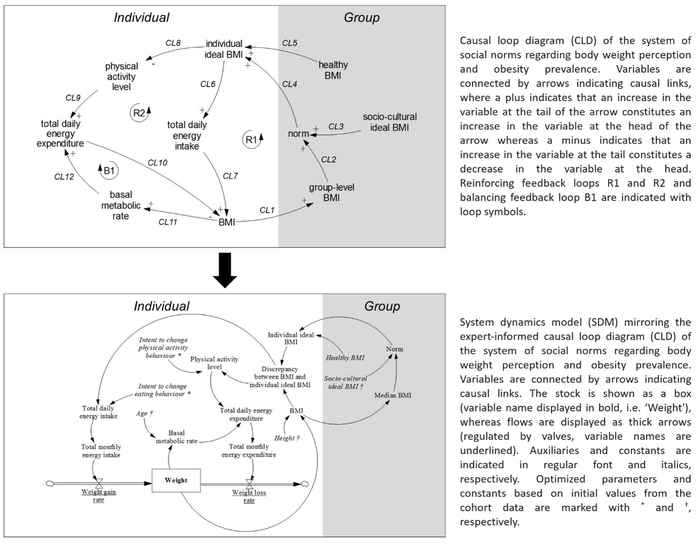1.8 Social norms and obesity prevalence: From cohort to system dynamics models.
Crielaard, L., Dutta, P., Quax, R., Nicolaou, M., Merabet, N., Stronks, K., & Sloot, P. M. (2020)
Keywords: causal loop diagram, system dynamics modelling, body weight perception, obesity, social norms
Author Pritha Dutta on the article:
It has been argued that individuals are more likely to underestimate their own body weight as obesity prevalence increases. That is because body weight perception, a determinant of overweight and obesity, is partly determined via social comparison. Body weight perception is thus affected by what is normal. It however also affects what is normal via its impact on obesity prevalence, inducing feedback loops that may over time result in complex behaviour, possibly inducing group-level obesity as an emergent property (for a framing of obesity as a group-level instead of an individual-level issue, see Ralston, J, et al., The Lancet, 392(10156), 1384-1386, 2018).
We modelled the system of social norms regarding body weight perception and obesity prevalence using system dynamics models (SDMs) to test the hypothesis that as overweight becomes normal, the norm might be counteracting health awareness in shaping individual weight-related behaviour. These SDMs are based on an expert-informed causal loop diagram and data from six sociocultural groups (Dutch, Moroccan and South-Asian Surinamese men and women).
Our results show that group-level BMI shifts to a lesser extent in all groups if norms have an influence on weight-related behaviour, confirming that norms are counteracting health awareness in shaping this behaviour. Particularly in groups where overweight is the norm, i.e. all male groups, the norm holds group-level BMI close to overweight despite of health awareness.
This paper is significant in the context of the current debate on addressing group-level determinants in policy aiming to reduce obesity prevalence. Although policies often start with a commitment to deal with group-level determinants, they frequently end up with the implementation of individualized interventions aimed at changing individual weight-related behaviour. A failure to tackle group-level determinants may be because – although there is a large body of knowledge on the way these determinants shape public health problems – the knowledge base regarding the impact of interventions addressing these determinants is limited. Currently, the evaluation of interventions aimed at higher level determinants is largely dependent on ‘natural experiments’, an approach that has proven to be extremely complex and heavily dependent on the very few actual policies that lend themselves for impact evaluation. The use of complexity science is likely to speed up knowledge production in this field. Our study is an attempt to explore the value of this approach, specifically for the issue of tackling overweight and obesity.
The relevance of addressing norms to change individual health-related behaviour as a policy strategy has received attention with respect to smoking. Understanding the interaction between group-level social norms and individual-level behaviour is also significant in relation to “collective action problems” such as climate change, where “no individual has sufficient incentive to act alone” (see Nyborg. K., et al., Science, 354(6308), 42-43, 2016).

Crielaard, L., Dutta, P., Quax, R., Nicolaou, M., Merabet, N., Stronks, K., & Sloot, P. M. A. (2020). Social norms and obesity prevalence: From cohort to system dynamics models. Obesity Reviews, 21(9), e13044.